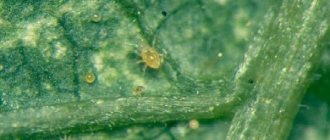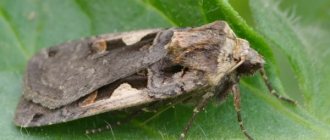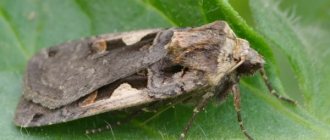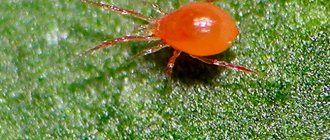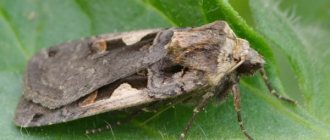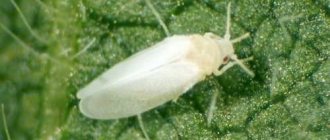Spider mite
In recent years, this microscopic insect has become a real nightmare for gardeners and gardeners.
Every year, spider mites destroy a significant part of the crop, and sometimes completely destroy the plants. Scientists associate the increase in the population of these harmful insects with global climate change. Winters in mid-latitudes have become much milder, allowing more females to survive. Another factor that complicates the fight against the pest is related to its size: the body of an adult female reaches 1 millimeter in length, males are even smaller.
There are several thousand species of spider mites worldwide, several hundred of which live in mid-latitudes. Insects have a bright scarlet, (Photograph) greenish or brown color and, as a rule, lead a secretive lifestyle. The mite's legs are equipped with special suction cups, with which it firmly attaches itself to tomatoes or other crops, then pierces the leaves and begins to suck the juice from the plant.
In its development from egg to adult, the spider mite goes through several stages. The life cycle of the male does not last long: 3-4 weeks, the female lives in diapause for several months, and the eggs of the parasite, under favorable conditions, remain viable for several years.
What kind of pest is this?
Spider mites on tomato seedlings are a common problem in all climate zones. These are small arachnids, about 0.5 mm in size. Females are slightly larger, males are slightly smaller. They reproduce very quickly: females lay up to 20 eggs every day during their life (up to 4 weeks). During hot weather, hatching from the egg can occur within 3 days, and after 5 days the larva turns into a mature tick.
What kind of pest is this
The photo shows what spider mites look like on tomatoes.
Differences from other pests
Spider mites weave thick webs on tomato seedlings. These nasty-looking silk threads protect the colony of parasites from predators.
The enormous reproduction rate makes the mite less sensitive to pesticides, so conventional plant treatment may be ineffective. Unfertilized females are still capable of bearing offspring - their eggs hatch exclusively into males.
Signs of spider mite damage to tomatoes
As a rule, the female spider mite emerges from diapause in mid-spring, towards the beginning of May. At this time, the insect prefers to settle on weeds, where it lays its eggs. Within a month (late May - early June), the tick moves to crop plantings and begins to actively parasitize them. At this time, it is very important to conduct a thorough inspection of the plants in order to detect signs of spider mite damage to tomatoes in time. Most often, the first pests choose the underside of young leaves, closer to the top of the tomato.
Finding small whitish or yellowish spots (Photo) or discolored areas indicates the presence of a parasite on your tomatoes. The spots formed at the site where the leaves were punctured, where the mite began to actively suck the vital juices from the plant. If you do not take immediate action, the leaves will soon begin to curl, dry out and fall off. After some time, it will be possible to see with the naked eye accumulations of cobwebs, indicating the presence of a large colony of insects.
It is along the web that the mite moves between parts of the plant or migrates to other tomato bushes. However, it would be extremely reckless on your part to wait for the web to appear - the fight against ticks must begin much earlier - long before the appearance of the parasite.
Prevention
Removing spider mites from a greenhouse is a costly and labor-intensive task, so it is worth taking into account the “tastes” of the pest and initially creating unfavorable conditions for it.
Several rules will help minimize the risk of insects:
It is necessary to carry out heat treatment of the soil for seedlings - this ensures that insects that hide in the soil will die. Warming in the oven will do. You should not make the rows of tomatoes too dense - this will facilitate the spread of mites throughout the planting. It is recommended to maintain a distance of 30 cm between the holes for planting seedlings in the greenhouse. It is recommended to plant crops that repel the pest next to the tomatoes. These include basil, dill, garlic, mustard, celery, chrysanthemum and calendula. Plants require adequate nutrition with phosphorus, introduced by the root method. The tick does not like soils saturated with the element. It is necessary to observe moderation in nitrogen fertilizing
Excess nitrogen in the soil favors the appearance of mites. It is important to keep the garden bed clean and prevent it from becoming overgrown with weeds. In autumn, tomato tops should be removed from the site and the soil should be dug deep.
In the fight or prevention against spider mites, it is important to remember that at risk are plants that are deficient in any resource (water, light, nutrition), weakened by diseases or mechanical damage. Not only special measures, but good care in general increases the resistance of tomatoes to pest damage
Owners of summer cottages often face such a problem as cobwebs on tomatoes. This indicates that the crop is attacked by spider mites - a pest that can attack plants in open ground, those growing in a greenhouse, and even indoors. And if there are a lot of insects, then such a colony can destroy almost the entire crop.
Spider mites are most often found on tomatoes.
Preventive measures
As you know, prevention is the best remedy against any disease, both human and plant. Of course, carrying out preventive work will take you some time, but it will most likely help you grow a good harvest of tomatoes, cucumbers, eggplants, and other vegetables or berries.
Prevention measures:
- Remove all debris from the site, paying special attention to removing fallen leaves, stems and other parts of the plant;
- Disinfect the soil if your area was infested with spider mites last summer. The soil can be spilled with boiling water, an acaricide solution, or sprinkled with a bleach solution, and then dug up;
- If you are growing tomatoes and other vegetables in a greenhouse, then be sure to carry out work to disinfect the soil, supporting structures and other surfaces of the greenhouse;
- It is better to begin work on disinfecting the greenhouse in the fall. After disinfection or replacement of soil, wash all accessible surfaces with an acaricidal solution, and then use sulfur bombs to disinfect the room; (Photo)
- Do not open the greenhouse for at least five days after using smoke bombs;
- Before planting tomato seedlings, carefully inspect and, if necessary, disinfect each plant. Often spider mite eggs, and even adults, end up in a bed of seedlings;
- When planting tomatoes, follow the rules of crop rotation. Do not plant tomatoes several times in the same place, make sure that crops prone to spider mite damage are not adjacent to each other;
- Do not thicken your beds; it is important that the tomatoes are well ventilated and ventilated;
- Water tomatoes in open ground in a timely manner. Create in the greenhouse the most unfavorable microclimate for spider mites: humidity above 85% at temperatures up to 250C;
- Inspect the plants regularly and remove debris near the roots. Provide sufficient amounts of phosphorus fertilizers and limit the use of chemicals with large amounts of nitrogen;
- Some gardeners place sticky tape around the bushes, which traps and kills harmful insects.
Reviews from experts
Magdalene:
Recently I saw a spider mite on my tomatoes and realized that the process was deeply advanced, since the seedlings were all affected by spider webs! Everything is in terrible condition. On the forums it was recommended to use Fitoverm, since it is less dangerous for humans. And indeed the drug coped with the affected areas.
Advantages: effective drug, easy to use;
Disadvantages: as with any chemical, it must be used carefully.
Innocent:
I plant tomatoes for sale, so it is important to me that the bushes produce a good harvest and I try to use less chemicals. And then a spider mite appeared. I used the biological drug Akarin. Easy to dilute and spray. I fought against the tick several times and got everyone out.
Every vegetable grower has to deal with a variety of pests that strive to destroy the crop. One of the biggest problems that calls into question not only the availability of crops, but also the very existence of plants is the invasion of spider mites on tomatoes and other vegetable crops.
This arthropod insect was first described in the mid-19th century; since then, scientists have proposed more than 50 classification options for the spider mite or Tetranychus urticae. But such a detailed description did not in any way contribute to the search for a 100% effective remedy to combat it.
You should not think that the appearance of Tetranychus urticae on your land is an absolute death sentence for your plantings and harvest. If you recognize the presence of the enemy in time and take action, you can still get rid of spider mites on tomatoes.
Ask and receive useful advice from professional gardeners and experienced summer residents.>>
Folk methods of struggle
If preventive measures do not give the desired result, it is necessary to move on to more effective measures to control pests. However, before using chemicals, we recommend taking advantage of the many years of experience that gardeners and gardeners have accumulated in fighting pests.
Garlic infusion . A simple and effective remedy, the preparation of which does not require special material costs, effort and time. Peel 500 grams of garlic cloves and chop them on a grater, using a meat grinder or under a press. Pour three liters of boiling water over the garlic mass, close the container well and leave to infuse in a dark place. After 7-9 days, open the infusion and strain it through several layers of gauze. Thus, you have received garlic concentrate, which is diluted with water in a ratio of 80 milliliters of concentrate per 10 liters of water. After mixing, add 100 grams of crushed laundry soap and stir until soap foam appears. Garlic infusion can be used for spraying and watering tomatoes, and it can also be used to wash leaves affected by spider mites.
Black henbane . This plant can also be used to control spider mites on tomatoes. However, one should take into account the high danger of the plant for humans: when preparing decoctions and infusions of henbane, we recommend following safety rules and wearing personal protective equipment. An infusion of henbane is prepared very quickly: take one kilogram of fresh herb, fill it with 10 liters of hot water and leave to infuse for 30-36 hours. After this, being careful, strain the infusion, add 100 grams of laundry soap to it and spray your tomatoes. Most often, several plant treatments will be needed.
Onion peel infusion
Infusion of onion peel. Another very popular folk remedy for treating tomatoes against spider mites.
To prepare the infusion, take 100-120 grams of onion peels and fill them with five liters of hot water. Cover the container and leave to steep for 7-8 days. After this period, strain the infusion and add 50 grams of liquid soap to it, stir until foam appears. The product can be used for spraying and watering tomatoes affected by spider mites.
Chemicals
If prevention and folk remedies do not bring the desired result, it makes sense to use agrochemicals, which are available in large quantities in specialized pharmacies and stores.
Actellik. One of the most popular and sought-after acaricides, it effectively controls spider mites at all stages of development and affects other pests. To treat tomatoes, dissolve one ampoule of the drug in one and a half liters of water, then stir the solution and pour it into a spray bottle. Actellik is a highly toxic chemical; we strongly recommend wearing gloves and a protective mask when working with it. The drug has a prolonged period of protective action (up to four weeks, depending on weather conditions). Repeated treatment of tomatoes is allowed no earlier than 21 days after the first spraying;
Fitoverm. Another popular, and most importantly, effective and safe drug. Fitoverm does not accumulate in soil or fruits and does not cause addiction to spider mites. Total death of insects is observed already in the first hours after using Fitoverm, however, several sprayings of tomatoes will be required to completely destroy this pest. The only drawback of the drug is its unpleasant odor, which must be taken into account when working in greenhouses.
Fitoverm
Fufanon
Bitoxibacillin
Fufanon. Anti-mite. These drugs have different names and manufacturers, but practically do not differ from each other, since they are based on one active ingredient - malathion. The chemicals effectively control a wide range of pests, including spider mites. Another advantage of malathion is its low toxicity; however, we would recommend using a mask and gloves when working with Fufanon or Antiklesch. The chemicals have contact, intestinal and fumigation effects; the period of protective action can reach (under favorable weather conditions) two weeks.
Reasons for the appearance of ticks on the site
The common spider mite parasitizes not only tomatoes in a greenhouse or open ground. More than 200 species of cultivated plants serve as food supply for it.
Where does it winter
Fertilized female spider mites are able to withstand temperatures down to -28° C, and overwinter in open ground, on plant debris that is not harvested at the end of the season, under the bark of trees. Especially many of them survive in greenhouses if sanitation was not carried out in the fall or was done poorly.
As soon as the temperature rises to 12 ° C, female spider mites come out of hiding and lay fertilized eggs, from which individuals of both sexes hatch. In spring, arachnids colonize weeds in the ground, where the first generations develop. Then they move to trees, garden and ornamental plants.
Fertilization is not necessary for eggs to hatch into adults. It’s just that if males did not participate in reproduction, only males hatch. The first clutch consists exclusively of fertilized eggs.
How it spreads
In greenhouses in the spring, spider mites feel especially comfortable on tomato seedlings. The leaves of newly planted plants lose turgor and are easy to bite through for microscopic arachnids.
Even if the area is clean, the soil and greenhouse have been treated from pests since the fall, this will only delay the appearance of spider mites. It is carried by the wind, animals, birds, insects, and enters the area by sticking to a person’s shoes or clothing. And only then it spreads with every fallen or torn infected leaf, on dirty hands or tools.
Favorable conditions
Depending on the climate, 8-18 generations appear per season. Greenhouse conditions are especially favorable for the spread of mites. The maximum number of generations develops there.
At first, spider mites are controlled by low temperatures and high humidity (if it rains in the spring). The population grows slowly, although each female lays 150 eggs at a time on the underside of the leaves, first entwined with a thin web.
The full development cycle - from laying to an adult sexually mature individual (imago) of a tick lasts 8-20 days. The higher the temperature, the faster a new generation appears.
As soon as the thermometer shows 29–31° C, and the humidity drops to 35–55% due to the heat, the pest begins to develop rapidly. In southern gardens it often attacks tomatoes in the summer, especially in the absence of rain. In greenhouses, the arachnid feels at ease, regardless of the region, and manifests itself much earlier than in open ground.
Advantages and disadvantages of using chemicals
Advantages:
- Diverse selection of chemicals on the market;
- Wide spectrum of action (most acaricides affect not only spider mites, but also other pests;
- Chemicals affect not only adults and larvae, but also tick eggs;
- Many drugs are not addictive to insects and do not accumulate in soil and fruits.
Flaws:
- High-quality chemicals are quite expensive;
- Some drugs have a high degree of toxicity. They can be harmful to human health;
- There are many counterfeits of original products on the market.
Fighting spider mites on tomatoes: advice from gardeners
Anton Komaritsky, 63 years old, Tambov region:
After retirement, I decided to take up gardening: I have a lot of free time, I still have health - I grow vegetables both for myself and for sale. And everything would be fine, except that spider mites have become addicted to my tomatoes and cucumbers. I didn’t even know that such an insect existed. In the first year, the mite destroyed half the crop. Now I approach the issue of protecting vegetables in a comprehensive manner: I carry out a lot of preventive measures, and then treat them with Fufanon two more times. I won’t say that I completely managed to get rid of this parasite, but it no longer has a significant effect on the harvest.
Anna Sevidova, 48 years old, Kursk region:
We grow tomatoes in the open ground for ourselves and some for sale. Spider mites have been causing trouble for a long time. It is clear that it lives in the ground and is not easy to destroy. Every year we dig up and disinfect the soil twice (in autumn and spring), but it is not possible to completely destroy the females and eggs of the insect. If the winter was warm and the summer was dry, then the pest attacks the garden in incredible quantities. In such years we use Actellik. I know that the chemical is toxic, but one treatment per season is enough.
How does infection occur?
Despite its tiny size, spider mites are capable of destroying your entire tomato crop in a short time. And if this enemy managed to get into your greenhouse, then the harvest of future periods is also at risk. Therefore, chemical and mechanical methods of getting rid of this parasite are a very hotly discussed topic among vegetable growers.
However, before you run to the chemical store and stock up on poisons, you should find out how spider mites become infected. Knowing how it gets onto the site, you can try to prevent infection of plants.
Spider mites are very small, so it is simply impossible to notice them with the naked eye. This harmful insect lives in fallen leaves and on the remains of last year's crop, which is already infected.
During the period of cold weather, the insect successfully hides under the ground covered with film or branches, under stones and foliage, and with the arrival of spring warmth it begins to actively reproduce and attack young plants.

